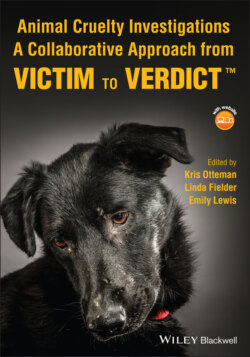Читать книгу Animal Cruelty Investigations - Группа авторов - Страница 112
2.5.1 Hoofstock
ОглавлениеCattle, including beef and dairy breeds, llamas, alpacas, and sheep, including meat and wool breeds, and a variety of goats fall into the category that is referred to as hoofstock. These animals are all grazing and foraging animals that may have access to a range and can seek food freely or may be confined and (Figure 2.1) fed in a pasture, feedlot, or dairy environment. Food consumption can be estimated based on body weight and ranges from 1% to 4%, depending on the species, life stage, and productivity. High‐producing dairy cattle will consume 4% of their body weight (50 lb dry feed for a 1200 lb cow) per day, while a pet pygmy goat that spends her day resting and playing will consume 1 lb of food a day. Water consumption can also be calculated based on the same concepts of weight, species, utilization, and environment. With access to clean water, these animals will drink what they need. Hoofstock have a natural tendency to wear hooves down to a healthy length and shape, but in some cases require hoof care such as shaping and trimming. Regular deworming for intestinal and external parasites is required on a routine basis and is dependent upon the region and environment the animals live in. Some breeds of cattle and goats are dehorned early in life and certain breeds of sheep are tail docked as lambs to prevent fly attraction and damage during warm periods. Many of these breeds are ear tagged or microchipped for identification purposes and for registration with breed affiliates and government agencies as required. Breeding progress in sheep and cattle is monitored in some herds by use of paint markers that apply a color blot to the female's back when she is bred. All these species give birth in a pasture or barn setting unaided in most situations, but emergency procedures and veterinary intervention may be necessary when dystocia (difficulty birthing) arises. Breeds of goats, sheep, alpacas, and llamas grow long thick coats that may require shearing. Body condition can be difficult to evaluate in these species without a hands‐on opportunity as the coat obscures their body, while visual evaluation is fairly straightforward for cattle breeds or short‐coated goats.
Figure 2.1 Feed requirements for cattle and other hoofstock can be calculated based on the animals' average or estimated ideal weight.
Source: Oregon Humane Society.
